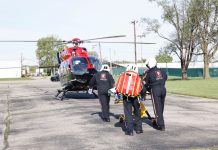Columbus North High School junior Cierra Sconce hefts a metal grate onto a welding table. Around the shop, high school students are cloistered in welding booths.
These high school students are learning the basics of the craft, working on blank slabs of scrap metal, which won’t be damaged if the teenagers make a mistake.
But Sconce and four male classmates with the C4 program at North are working on something different — 15 feet of custom fabricated hand railing to be installed in a house at 2718 Violet Way, which is being built by one of the C4 building trades classes down the hall.
Sconce’s classmate, senior Jonathan McIntosh, said Sconce excels at tungsten inert gas welding, one of the more challenging types which is used to create small, intricate seams.
[sc:text-divider text-divider-title=”Story continues below gallery” ]
So, it falls to Sconce, the only second-year welding student in the group, to put together small, careful connections between each steel rod for the hand railing.
The high school building trades class builds a new home in Columbus nearly every year. Over the last two years, the class instead constructed new buildings at the Columbus North baseball diamond.
But, this is the first time since welding instructor Derik Gratz returned to teaching at North this year that custom fabricated parts have been included in the home’s building plans, he said.
Gratz spent all of last year working for Bruce Welding and Fabrication in Bloomington making and installing unique handrails and security gates at area homes. He still works with the company part time, he said.
So the idea of leading students through a similar project seemed like a natural extension of his many art projects, he said.
Metalworking is more than a job or a class for Gratz, he said. Scattered around his classroom and workshop are his various welded art pieces, which include a near-perfect reproduction of a human hand rendered in artificially rusted steel and plasma-cut emblems from both East and North High Schools in blackened sheet metal.
But for most of the five students involved in the project, welding also is about a future career. Sconce, McIntosh and Jesse Eckstein are considering long-term careers in welding and fabrication. Junior Logan Ault, who is also helping with the project, plans to go into high performance motorsports design and repair.
“I come from a family of tradesman,” Sconce said. And she plans to continue down this path, eventually obtaining her welding certification before moving into electrical work. Darren Carr, another senior working on the project, would eventually like to start his own welding and fabrication shop.
Enrollment in the welding program has been pretty consistent over the last few years at around 60 students, Gratz said.
Students who complete the full round of welding classes through the C4 program at North are eligible to complete their professional certification through the American Welding Society. This is the group’s minimum professional requirement needed to work as a welder in a general factory setting or in petroleum pipelines, Gratz said. Other certifications and endorsements cover various materials or industries, with training usually provided by the employer, he added.
According to the Indiana Department of Labor, starting wages for a basic certified welder range from about $33,000 per year to $37,000 per year depending on specialization. The Federal Bureau of Labor Statistics reports nearly 400,000 welding jobs in the United States, with market growth of about 14,400 during the next 10 years.
Certification opens doors to a huge variety of jobs ranging from manufacturing to metal arts, Gratz said.
But, as an experienced fabricator, Gratz said the technical skills are the easy part. Collaborating on original ideas is far more difficult.
For that reason, he wanted to encourage some of his students to build unique, custom parts for a real project.
Students in the C4 welding program already do most of the metal repair work at various schools, under Gratz’s direction. Recently, the class worked on repairing a broken kick plate on one of the water fountains and damaged aluminum on a people-mover device used to transport special education students, both at Columbus North.
Gratz is already designing the next class project, an all-steel sign for front lawn of the historical Columbus home of the Reeves family, founders of the Reeves Pulley Co.
But before he can jump into that project, students will need to complete work on the material for the house, Gratz said.
Fabrication of the handrails started during the last week of February and are expected to be finished soon, Gratz said. Following spring break, the pieces will temporarily be fitted in place before being returned to the shop for powder coating. Permanent installation will take place sometime before the end of the semester.
Final work on the completed house should be completed before the end of the school year, said Gene Hack, C4 director.
The custom railings are a permanent part of a home, which will be sold to a private owner and will not be on display to the public, Gratz said.
[sc:pullout-title pullout-title=”To learn more” ][sc:pullout-text-begin]
For more information on Columbus C4 programs, visit bcsc.k12.in.us/domain/1451.
[sc:pullout-text-end]




